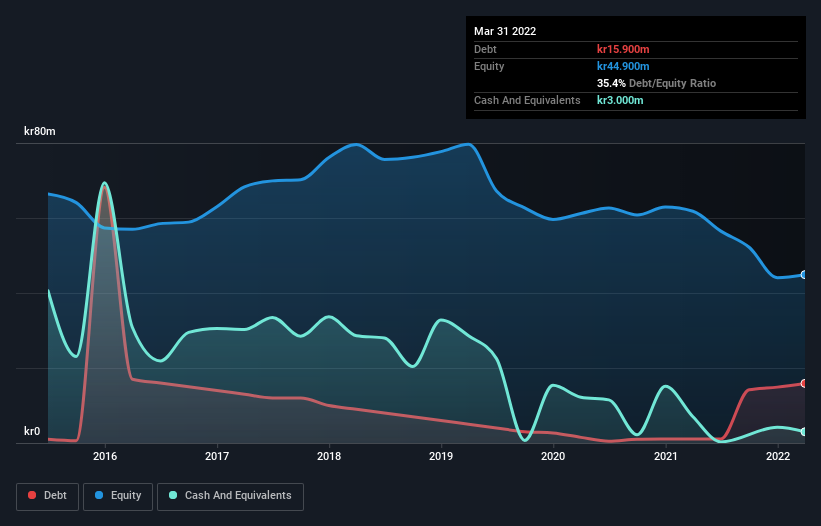- Sweden
- /
- Professional Services
- /
- OM:HULT B
Hifab Group AB (publ.) (STO:HIFA B) Is Carrying A Fair Bit Of Debt
Warren Buffett famously said, 'Volatility is far from synonymous with risk.' So it seems the smart money knows that debt - which is usually involved in bankruptcies - is a very important factor, when you assess how risky a company is. As with many other companies Hifab Group AB (publ.) (STO:HIFA B) makes use of debt. But is this debt a concern to shareholders?
When Is Debt A Problem?
Debt and other liabilities become risky for a business when it cannot easily fulfill those obligations, either with free cash flow or by raising capital at an attractive price. Part and parcel of capitalism is the process of 'creative destruction' where failed businesses are mercilessly liquidated by their bankers. While that is not too common, we often do see indebted companies permanently diluting shareholders because lenders force them to raise capital at a distressed price. By replacing dilution, though, debt can be an extremely good tool for businesses that need capital to invest in growth at high rates of return. The first thing to do when considering how much debt a business uses is to look at its cash and debt together.
View our latest analysis for Hifab Group AB (publ.)
What Is Hifab Group AB (publ.)'s Net Debt?
As you can see below, at the end of March 2022, Hifab Group AB (publ.) had kr15.9m of debt, up from kr1.10m a year ago. Click the image for more detail. On the flip side, it has kr3.00m in cash leading to net debt of about kr12.9m.

How Healthy Is Hifab Group AB (publ.)'s Balance Sheet?
According to the last reported balance sheet, Hifab Group AB (publ.) had liabilities of kr94.3m due within 12 months, and liabilities of kr7.90m due beyond 12 months. On the other hand, it had cash of kr3.00m and kr99.3m worth of receivables due within a year. So these liquid assets roughly match the total liabilities.
This state of affairs indicates that Hifab Group AB (publ.)'s balance sheet looks quite solid, as its total liabilities are just about equal to its liquid assets. So it's very unlikely that the kr139.9m company is short on cash, but still worth keeping an eye on the balance sheet. When analysing debt levels, the balance sheet is the obvious place to start. But you can't view debt in total isolation; since Hifab Group AB (publ.) will need earnings to service that debt. So when considering debt, it's definitely worth looking at the earnings trend. Click here for an interactive snapshot.
Over 12 months, Hifab Group AB (publ.) made a loss at the EBIT level, and saw its revenue drop to kr307m, which is a fall of 10%. We would much prefer see growth.
Caveat Emptor
While Hifab Group AB (publ.)'s falling revenue is about as heartwarming as a wet blanket, arguably its earnings before interest and tax (EBIT) loss is even less appealing. Indeed, it lost a very considerable kr15m at the EBIT level. Looking on the brighter side, the business has adequate liquid assets, which give it time to grow and develop before its debt becomes a near-term issue. But we'd want to see some positive free cashflow before spending much time on trying to understand the stock. So it seems too risky for our taste. When analysing debt levels, the balance sheet is the obvious place to start. However, not all investment risk resides within the balance sheet - far from it. Be aware that Hifab Group AB (publ.) is showing 5 warning signs in our investment analysis , and 2 of those are significant...
If you're interested in investing in businesses that can grow profits without the burden of debt, then check out this free list of growing businesses that have net cash on the balance sheet.
Valuation is complex, but we're here to simplify it.
Discover if Hultstrom Group might be undervalued or overvalued with our detailed analysis, featuring fair value estimates, potential risks, dividends, insider trades, and its financial condition.
Access Free AnalysisHave feedback on this article? Concerned about the content? Get in touch with us directly. Alternatively, email editorial-team (at) simplywallst.com.
This article by Simply Wall St is general in nature. We provide commentary based on historical data and analyst forecasts only using an unbiased methodology and our articles are not intended to be financial advice. It does not constitute a recommendation to buy or sell any stock, and does not take account of your objectives, or your financial situation. We aim to bring you long-term focused analysis driven by fundamental data. Note that our analysis may not factor in the latest price-sensitive company announcements or qualitative material. Simply Wall St has no position in any stocks mentioned.
About OM:HULT B
Hultstrom Group
Provides project management and consulting services in Sweden, rest of Europe, Asia, and Africa.
Solid track record with excellent balance sheet and pays a dividend.
Market Insights
Community Narratives



